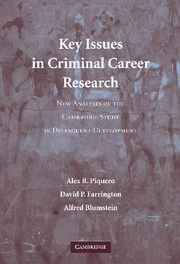 Key Issues in Criminal Career Research
Key Issues in Criminal Career Research Published online by Cambridge University Press: 30 July 2009
Are there distinct patterns of offending over time such that some individuals follow one course (e.g., peaking in adolescence and desisting as adulthood approaches) over another (e.g., peaking early in life, remaining active throughout life, and hardly desisting later in life)? Or is it the case that most offenders follow a similar path to offending such that it is unnecessary to postulate distinct patterns of offending and the theoretical and methodological complexity associated with them? Such questions strike at the heart of classic and contemporary criminological debates as well as policy discussions, options, and decisions.
One set of theorists claims that there are two different groups of offenders, each exhibiting a distinctive shape, peak, and pattern of offending over the life-course (e.g., Moffitt, 1993; Patterson, 1993). The first group is believed to be characterized by a very small number of individuals who evince an early onset of offending and a fairly flat trajectory of criminal activity throughout much of the life-course. These individuals offend early, offend more often while active, and are relatively unlikely to desist. A second group of offenders is believed to be characterized by a relatively large number of individuals who first engage in delinquent and criminal activity in their teenage years; however, at some point in their early adulthood these individuals curtail their offending activity and move on to more conventional adult patterns.
To save this book to your Kindle, first ensure [email protected] is added to your Approved Personal Document E-mail List under your Personal Document Settings on the Manage Your Content and Devices page of your Amazon account. Then enter the ‘name’ part of your Kindle email address below. Find out more about saving to your Kindle.
Note you can select to save to either the @free.kindle.com or @kindle.com variations. ‘@free.kindle.com’ emails are free but can only be saved to your device when it is connected to wi-fi. ‘@kindle.com’ emails can be delivered even when you are not connected to wi-fi, but note that service fees apply.
Find out more about the Kindle Personal Document Service.
To save content items to your account, please confirm that you agree to abide by our usage policies. If this is the first time you use this feature, you will be asked to authorise Cambridge Core to connect with your account. Find out more about saving content to Dropbox.
To save content items to your account, please confirm that you agree to abide by our usage policies. If this is the first time you use this feature, you will be asked to authorise Cambridge Core to connect with your account. Find out more about saving content to Google Drive.